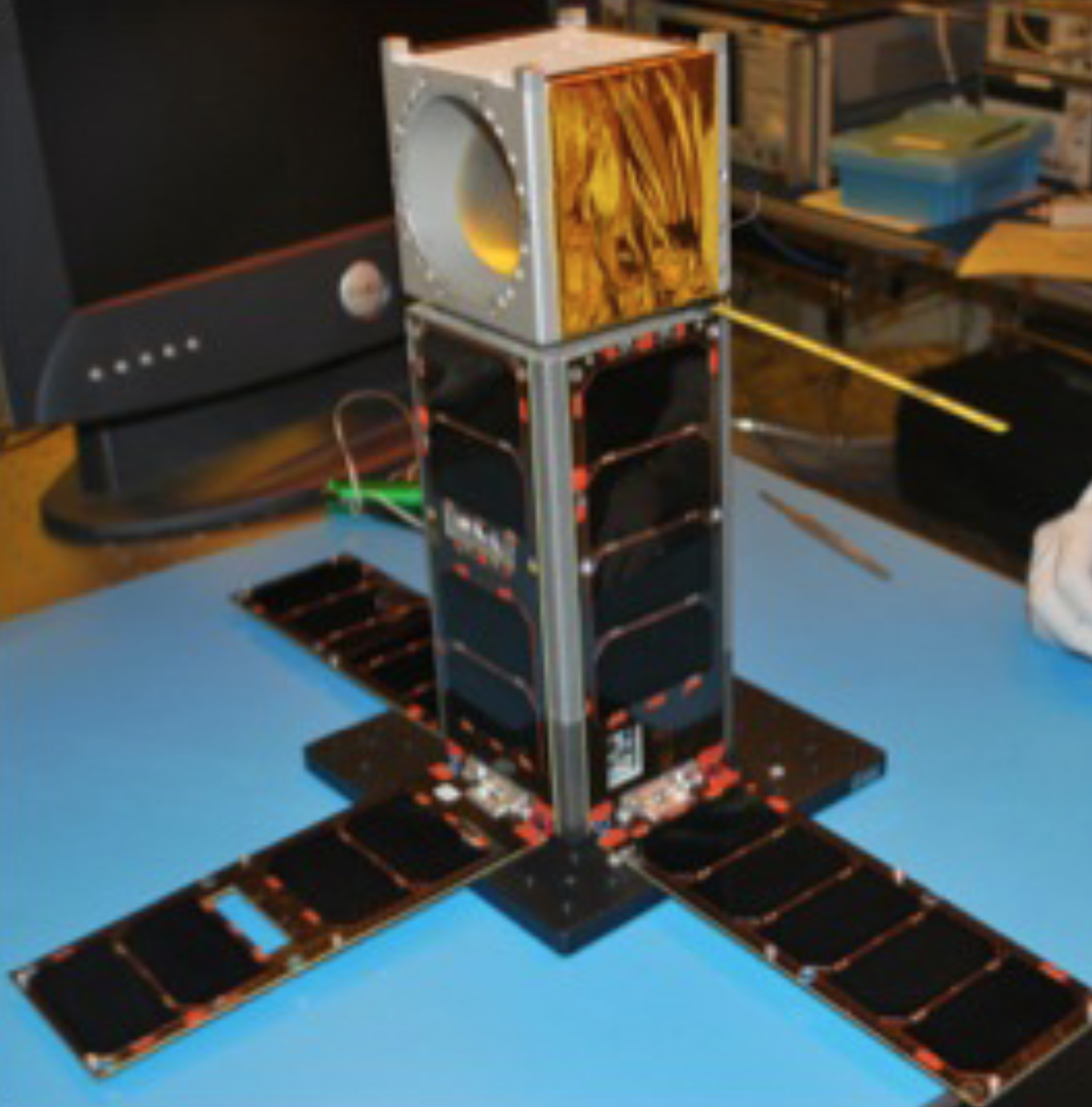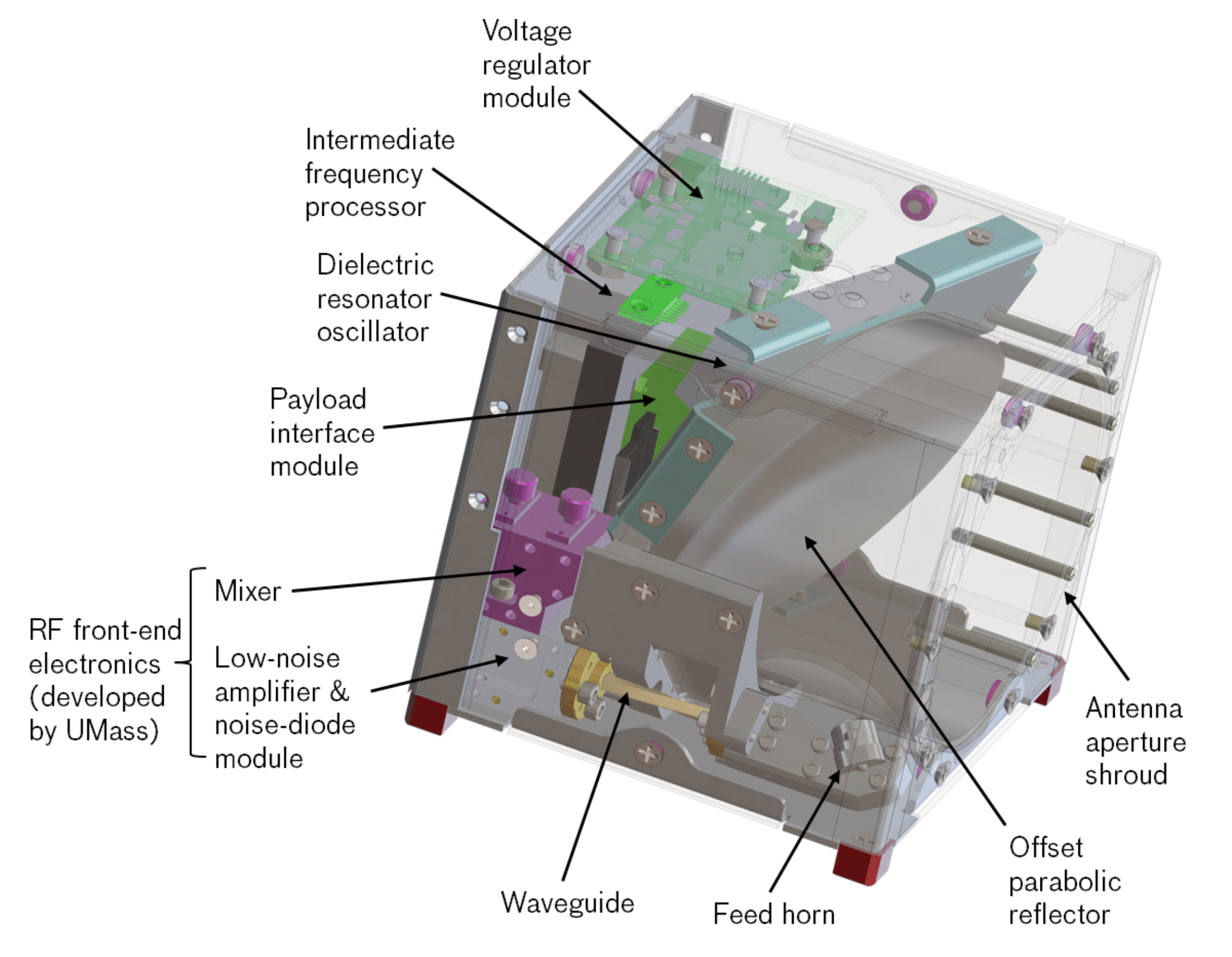Tech notes
Micro-sized Microwave Atmospheric Satellite
A miniature satellite may be the innovative solution to minimizing the expense of atmospheric monitoring.
Weather forecasts are critical to effectively planning activities. From the mission scheduler setting a date for a satellite launch, to the relief agency coordinating responses to a natural disaster, to the ship's navigator plotting a course, decision makers need to be prepared for the potential impacts of weather. The U.S. National Oceanic and Atmospheric Administration (NOAA), which investigates and provides weather information and climate monitoring, is highly interested in improving the forecasting and tracking of severe weather systems such as hurricanes because of their serious impacts on the health of the nation's citizenry, agriculture, critical infrastructure, and communications.
 The complete Micro-sized Microwave Atmospheric Satellite contains the radiometer installed at the top and the CubeSat bus whose solar panels open out once in orbit.
The complete Micro-sized Microwave Atmospheric Satellite contains the radiometer installed at the top and the CubeSat bus whose solar panels open out once in orbit.Essential for understanding the nature of severe weather systems are accurate measurements of temperature and water-vapor profiles from the surface up to approximately 20 km. Storm intensity can be predicted on the basis of the abundance and size of cloud ice particles, the scattering of which is measured by passive microwave observations. Observations that are timely and cover wide expanses of the globe are also indispensable for forecasting and monitoring powerful storms.
Currently, the data used to create the numerical weather-prediction (NWP) models that support severe weather monitoring are provided by instruments aboard large satellites. While the data from these instruments are reliable, the high cost of the instruments and the host spacecraft limits data collection. The single-unit pricetag of hundreds of millions of dollars prohibits the deployment of more than a few satellites and therefore precludes the most complete and up-to-date coverage of evolving weather. Weather observations over many regions of the world are temporally sparse primarily because of the cost of fielding the necessary systems.
Potential Solution to Expensive Weather Monitoring
MIT Lincoln Laboratory in collaboration with the Space Systems Laboratory at MIT campus has developed a prototype nanosatellite that could make weather measurement less expensive. Called the Micro-sized Microwave Atmospheric Satellite, or MicroMAS, this small (30 cm x 10 cm x 10 cm) spacecraft has a three-axis-stabilized CubeSat bus on which is integrated an ultracompact radiometer for taking measurements of atmospheric temperature. When MicroMAS is ejected from a host satellite, it will fly with its solar panels opened out like petals of a flower. These panels will supply energy during half of MicroMAS's orbit around Earth and charge the batteries used for power during the other half-orbit. Once deployed, MicroMAS will collect multispectral, millimeter-wave, radiometric images of severe weather systems with its radiometer spinning perpendicular to the satellite track at 40 rpm.
In July 2014, MicroMAS will be carried aboard Orbital Science's Cygnus spacecraft being launched on NASA's Antares rocket from Wallops Island, Virginia. After Cygnus, which is delivering supplies and scientific equipment to the International Space Station, docks with the station (about three days post-launch), MicroMAS will be deployed into orbit for its proof-of-concept demonstration. For three months, MicroMAS will be sending data back to a ground terminal at Wallops Island. Researchers anticipate that hundreds of thousands of observations will be relayed daily. If MicroMAS performs well and captures usable data, the demonstration could lead to a new strategy for making measurements needed for numerical weather prediction models—deploying constellations of the nanosatellites. Because MicroMAS is relatively inexpensive to build—the first unit costs about $2 million and subsequent units would cost less than half of that if dozens are built simultaneously—a constellation would cost the same as or less than one large satellite, including ground segment and launch expenditures. An array of MicroMASes would provide observations over a wide area; a constellation could provide coverage over much of Earth's surface.
 The computer-aided design drawing shows the details of the radiometer aboard MicroMAS.
The computer-aided design drawing shows the details of the radiometer aboard MicroMAS.Engineering Challenges
The idea seems simple: employ a small, affordable satellite instead of a big, expensive one. However, the realization of that concept was an engineering challenge. MicroMAS is the most complicated CubeSat ever flown. The instrumentation had to be scaled down to fit on the 4-inch "cube" bus; this task was one of the most difficult of the project. Lincoln Laboratory tapped into new technologies for miniaturization and low-power electronics in developing the MicroMAS radio frequency front-end and intermediate-frequency processor. The University of Massachusetts at Amherst developed the receiver electronics using low-power monolithic microwave integrated-circuit technology. While many of MicroMAS's components are commercial off-the-shelf hardware, the electronics supporting the subsystems were custom built. Designing the software for the system was also demanding, as power constraints limited the available computational resources.
The MicroMAS bus was developed by a team from MIT's Space Systems Laboratory, which included faculty from the Department of Aeronautics and Astronautics and their students. One of the most complex pieces of this unit was the attitude determination and control subsystem (ADCS) that orients the nanosatellite and keeps it reasonably level with Earth's surface while it is spinning along the orbital path. The ADCS also had to be designed to compensate for the angular momentum of the comparatively heavy (1 kilogram) radiometer payload, which must rotate relative to the fixed bus.
Before being deemed ready for launch, MicroMAS was extensively tested. Because the extreme temperatures in space can seriously limit a spacecraft's survivability or degrade its performance, MicroMAS was run through multiple trials at various temperatures in a thermal vacuum cham- ber in the environmental testing facility at Lincoln Laboratory. Calibration tests of the radiometer were performed over a range of target temperatures to assess instrument performance. Vibration testing was done on the unit to ensure that it would survive the harsh mechanical environment to be encountered on launch. The ADCS was tested first at the Space Systems Laboratory to verify its ability to maintain the attitude and stability of the CubeSat, and then at Lincoln Laboratory to confirm sta- bilization with the payload integrated on the bus. The tests have concluded that for MicroMAS "all systems are a go."
The research team expects to start receiving data from MicroMAS about a day after its ejection into orbit. A successful demonstration of the system could stimulate further investigation into a rapid-development process for building "fleets" of low-cost nanosatellites that could provide wide-area weather measurements for improved understanding and monitoring of intense storms.
Posted July 2014
top of page